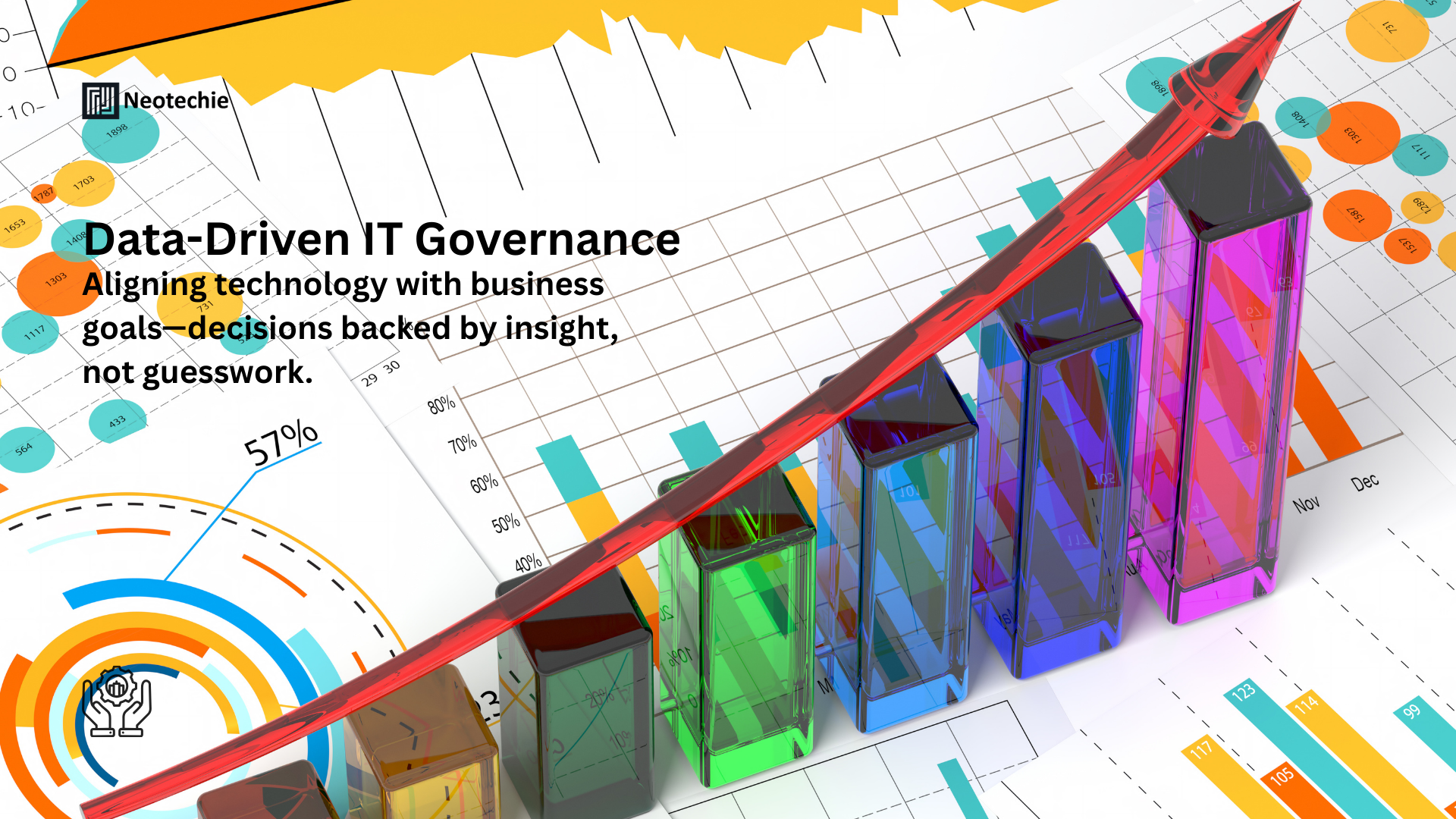Data-Driven IT Governance: Aligning Technology with Business Objectives
In the digital-first era, businesses succeed or fail based on how well they align technology investments with strategic objectives. Without strong governance, IT often operates in silos, leading to inefficiencies, security risks, and misaligned priorities. Data-Driven IT Governance provides the framework to ensure that every IT decision is measurable, transparent, and directly tied to business outcomes.
What is Data-Driven IT Governance?
Data-driven IT governance is a structured approach where data and analytics guide IT decision-making. It ensures that policies, systems, and technology implementations are aligned with corporate strategy. The goal isn’t just to manage IT but to create business value by:
- Establishing clear accountability for IT initiatives, so business leaders know exactly who is responsible for outcomes.
- Measuring the ROI of IT investments, ensuring that every dollar spent drives measurable growth or efficiency.
- Strengthening compliance and risk management by identifying vulnerabilities early.
- Optimizing resource allocation based on actionable insights rather than guesswork.
- Driving continuous improvement through regular evaluation and adjustment.
Why Data-Driven IT Governance Matters
1. Alignment Between Business and IT
Without governance, IT often becomes disconnected from organizational priorities. Projects may consume resources but fail to deliver business value. Data-driven governance ensures alignment by tying technology initiatives directly to business KPIs such as revenue growth, customer satisfaction, or market expansion. This eliminates silos and builds stronger collaboration between IT leaders and business executives.
2. Measurable ROI from Technology
Technology investments are only valuable if they contribute to tangible results. Data-driven governance makes IT accountable by tracking cost savings, productivity gains, and revenue impact. For instance, when deploying a new CRM system, governance frameworks measure adoption rates, customer engagement, and retention to prove ROI.
3. Risk and Compliance Management
Organizations today face cyberattacks, data breaches, and regulatory scrutiny. Without governance, risks can remain hidden until they become costly. A data-driven framework provides real-time visibility into vulnerabilities, tracks compliance status across regulations like GDPR or HIPAA, and ensures mitigation strategies are in place.
4. Resource Optimization
Many businesses either overspend on unnecessary technologies or underfund critical initiatives. With governance, data identifies which projects deliver the highest return, enabling smarter allocation of budgets, talent, and infrastructure. This prevents waste and ensures resources are aligned with priorities.
5. Agility in a Changing Market
Markets shift rapidly with evolving customer demands, competition, and disruptive technologies. Data-driven governance frameworks enable IT leaders to make informed pivots. For example, if analytics show declining adoption of a legacy system, governance supports timely migration to cloud-based alternatives that enhance agility.
How Data-Driven IT Governance Works
Step 1: Establish Business-Centric KPIs
Instead of generic IT metrics like uptime alone, governance frameworks define business-focused KPIs. These might include revenue impact of a digital initiative, reduction in compliance costs, or customer satisfaction improvements.
Step 2: Implement Monitoring Tools
Dashboards and analytics platforms provide continuous tracking of IT performance, including system reliability, resource usage, project delivery times, and cost efficiency. This visibility ensures decisions are based on facts, not assumptions.
Step 3: Enforce Accountability
Governance committees assign ownership for initiatives. CIOs, CTOs, or department heads are accountable for outcomes, ensuring that IT projects don’t drift without oversight. Data-backed accountability fosters trust across leadership.
Step 4: Continuous Review and Adjustment
Markets evolve, and governance must evolve too. Regular audits, quarterly reviews, and automated alerts help organizations adapt governance practices. Continuous monitoring ensures strategies remain relevant and aligned with long-term goals.
Key Focus Areas of Data-Driven Governance
- IT Portfolio Management – Prioritizing projects based on measurable business value. For example, investing in AI-driven automation may yield faster returns than upgrading non-critical legacy systems.
- Risk & Compliance Monitoring – Proactively scanning for threats, monitoring data privacy practices, and ensuring compliance with regulatory frameworks to prevent penalties.
- Resource Optimization – Using analytics to identify underutilized resources, consolidating systems, and reallocating funds toward initiatives with higher ROI.
- Performance Measurement – Creating transparent benchmarks that measure cost efficiency, employee productivity, customer experience, and system reliability.
- Innovation Enablement – Striking a balance between governance and creativity, ensuring that risk controls don’t limit innovation but instead provide a safe environment for experimentation.
Business Benefits
- Improved ROI on IT investments by demonstrating clear connections between spending and business outcomes.
- Enhanced accountability through data-backed decision-making, fostering greater trust in IT leadership.
- Greater resilience by proactively addressing risks and staying compliant with regulations.
- Operational efficiency by eliminating redundant systems and optimizing resources.
- Business agility through faster decision-making and the ability to pivot in response to emerging challenges.
Why Neotechie?
At Neotechie, IT governance is more than oversight—it’s about enabling business transformation. With expertise in analytics, IT strategy, compliance, and digital transformation, Neotechie builds governance frameworks that deliver measurable value. Their solutions include real-time dashboards, KPI-driven monitoring, and tailored governance models designed to match unique business goals. By aligning IT with enterprise strategy, Neotechie helps organizations maximize ROI, strengthen compliance, and achieve sustainable growth.

